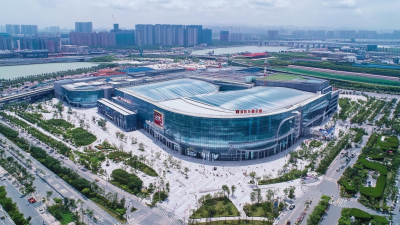As the pharmaceutical sector continues to evolve, the 138th China Import and Export Fair in 2025 emerges as a pivotal platform for showcasing innovative trends in Drug Studies. According to a recent report by Grand View Research, the global drug discovery market is projected to reach USD 63.4 billion by 2025, reflecting the increasing investment in research and development. This growth is fueled by advancements in biopharmaceuticals and personalized medicine, which are reshaping the landscape of drug studies. Furthermore, a report by the IQVIA Institute for Human Data Science indicates that over 6,000 drugs are currently in clinical development, highlighting an unprecedented focus on innovation. The upcoming fair will provide an opportunity for stakeholders in the pharmaceutical industry to engage with cutting-edge research and technologies, paving the way for breakthroughs that could redefine treatment paradigms and improve patient outcomes worldwide.

The 138th China Import and Export Fair in 2025 showcased remarkable advancements in drug development driven by emerging technologies. One of the most significant innovations is the integration of artificial intelligence and machine learning in drug discovery. These technologies enable researchers to analyze vast amounts of data swiftly and identify potential drug candidates more effectively. By predicting the interactions between drugs and biological systems, AI enhances the efficiency of the initial phases of drug development, thus significantly reducing the time and cost associated with bringing new medications to market.
Additionally, advancements in biotechnology, such as CRISPR and gene therapy, are transforming traditional approaches to treating diseases. These technologies empower scientists to target genetic disorders at their source, offering promising solutions for conditions that were once deemed untreatable. Furthermore, the rise of personalized medicine, facilitated by genomic sequencing, allows for tailored therapies that cater to individual patient needs. This shift not only improves patient outcomes but also paves the way for a new era in therapeutic strategies, transforming the landscape of the pharmaceutical industry by prioritizing precision and efficacy in drug development.

The growth of China's pharmaceutical market is a pivotal theme in the discussions surrounding the 138th China Import and Export Fair 2025. Data indicates that the market is expected to experience significant expansion, with the generic pharmaceuticals sector projected to achieve a remarkable growth rate, reaching approximately USD 8.877 billion by 2035, reflecting a CAGR of 8.877%. This growth is anticipated to be driven by advancements in drug development and a rising demand for affordable medication.
Another crucial area of focus is the overall size of the global pharmaceutical market, estimated to soar to USD 2,845.3 billion by 2032. This surge is largely attributed to increasing healthcare expenditures and innovations in drug research, particularly through biotechnology and AI-driven drug discovery. The pharmaceutical industry is witnessing a transformative period, where precision medicine and targeted therapies are becoming more commonplace, aligning with the evolving health needs of the population.
**Tip:** For stakeholders in the pharmaceutical sector, it’s essential to embrace digital transformation and innovation, as these trends are steering the industry towards greater efficiency and personalization in care. Monitoring market insights and adapting strategies in line with these evolving dynamics will be crucial to staying competitive.
The 138th China Import and Export Fair in 2025 is set to be a landmark event, particularly in the realm of drug studies and clinical trials. Innovations in clinical trials are emerging as a pivotal focus, driving both opportunities and challenges in the pharmaceutical landscape. According to the latest report by GlobalData, the global clinical trial market is anticipated to reach $62 billion by 2026, spurred by advancements in technology and patient-centric trial design. These changes not only enhance the efficiency of drug development but also improve patient recruitment and retention rates, making trials more inclusive and diverse.

However, alongside these opportunities, several challenges persist. Data from the Tufts Center for the Study of Drug Development indicates that the average cost of bringing a new drug to market has soared to nearly $2.6 billion, necessitating equally innovative approaches to streamline processes and reduce timeframes. Furthermore, regulatory complexities and the need for comprehensive data management systems continue to hinder the progression of clinical trials. Embracing digital platforms and real-world evidence can mitigate these challenges, enabling pharmaceutical companies to navigate the evolving landscape more effectively. The future of clinical trials hinges on harnessing these innovations while addressing the regulatory and operational hurdles that remain significant barriers to success.
The 138th China Import and Export Fair in 2025 showcased some of the most innovative trends in drug studies, with a particular focus on the transformative role of artificial intelligence (AI) in drug discovery and development. AI technologies have revolutionized the pharmaceutical landscape, significantly accelerating the drug discovery process. According to a report by Frost & Sullivan, AI-driven drug discovery is expected to reduce the time taken to identify viable drug candidates by up to 50%, creating immense efficiencies in the pipeline.
In addition to speed, AI enhances precision in drug development by utilizing machine learning algorithms to analyze vast datasets of biological and chemical information. A recent study published in Nature Biotechnology indicates that AI can predict drug-target interactions with over 90% accuracy, enabling researchers to identify promising candidates quicker than traditional methods. As the industry increasingly embraces AI, the potential for personalized medicine—tailoring treatments to individual patients based on genetic, environmental, and lifestyle factors—becomes increasingly feasible. This shift not only promises improved patient outcomes but also signifies a new era of medical innovation driven by technology.
| Dimension | Description | Impact on Drug Discovery | Future Prospects |
|---|---|---|---|
| Machine Learning Algorithms | Utilizing algorithms to predict molecular activity and toxicity. | Improves accuracy in candidate selection. | Potential to reduce time in development phases. |
| Natural Language Processing (NLP) | Analyzing scientific literature for data extraction. | Enhances knowledge retrieval in drug research. | Could lead to faster literature reviews and updates. |
| Data Integration Platforms | Combining various data sources for holistic analysis. | Aids in understanding complex biological systems. | Facilitates multi-disciplinary collaborations. |
| Cloud Computing | Providing scalable resources for large data analysis. | Enables efficient processing of big data. | Future growth in data-handling capabilities. |
| Predictive Analytics | Forecasting outcomes based on historical data. | Minimizes risk in drug development decisions. | Evolving methods to enhance prediction accuracy. |
At the 138th China Import and Export Fair in 2025, significant regulatory trends are emerging that are poised to reshape the future of pharmaceuticals in the country. As highlighted in a recent report by the China National Pharmaceutical Industry Information Center, the pharmaceutical market in China is expected to reach $170 billion by 2025, driven by evolving health policies and an increasing demand for innovative therapies. This growth is largely influenced by the Chinese government's commitment to accelerate drug approvals and foster a more transparent regulatory environment.
Recent reforms, such as the Drug Administration Law amendment and the implementation of the marketing authorization holder system, aim to streamline the approval process and enhance drug quality. According to the China Food and Drug Administration, the average drug approval time has decreased significantly, from over 100 days to around 60 days in recent years. This rapid transformation not only supports the development of new drugs but also promotes international collaboration, encouraging foreign investments and partnerships within China's pharmaceutical sector. The focus on regulatory clarity and efficiency is crucial for both domestic and international pharmaceutical companies looking to navigate this dynamic landscape.






